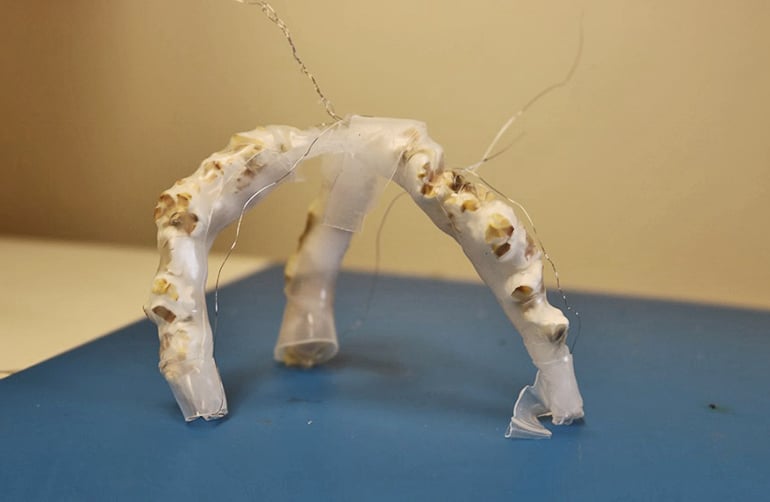Popcorn might be a way to power inexpensive robotic devices that grip, expand, or change rigidity, researchers say.
When it gets hot, popcorn can expand more than 10 times in size, change its viscosity by a factor of 10, and transition from regular to highly irregular granules with surprising force.
“The goal of our lab is to try to make very minimalistic robots which, when deployed in high numbers, can still accomplish great things,” says Kirstin H. Petersen, assistant professor of electrical and computer engineering at Cornell University, and head of the Collective Embodied Intelligence Lab.
“Simple robots are cheap and less prone to failures and wear, so we can have many operating autonomously over a long time. So we are always looking for new and innovative ideas that will permit us to have more functionalities for less, and popcorn is one of those.”

Eat this robot
The study is the first to consider powering robots with popcorn, which is inexpensive, readily available, biodegradable, and of course, edible.
Since kernels can expand rapidly, exerting force and motion when heated, they could potentially power miniature jumping robots. And people could even eat edible devices for medical procedures.
The mix of hard, unpopped granules and lighter popped corn could replace fluids in soft robots without the need for air pumps or compressors.
“Pumps and compressors tend to be more expensive, and they add a lot of weight and expense to your robot,” says lead author and doctoral student Steven Ceron.
“With popcorn, in some of the demonstrations that we showed, you just need to apply voltage to get the kernels to pop, so it would take all the bulky and expensive parts out of the robots.”
Since kernels can’t shrink once they’ve popped, a popcorn-powered mechanism is typically single-use, though multiple uses are conceivable because popped kernels can dissolve in water, Ceron says.
The researchers experimented with Amish Country Extra Small popcorn, which they chose because the brand did not use additives.
The expansion of the kernels was strong enough to support the weight of a nine-pound kettlebell.
After studying popcorn’s properties using different types of heating, the researchers constructed three simple robotic actuators—devices that perform a function.
For a jamming actuator, 36 kernels of popcorn heated with nichrome wire were used to stiffen a flexible silicone beam. For an elastomer actuator, they constructed a three-fingered soft gripper, whose silicone fingers were stuffed with popcorn heated by nichrome wire. When the kernels popped, the expansion exerted pressure against the outer walls of the fingers, causing them to curl.
Tiny robotic fly gets power from laser beam
For an origami actuator, they folded Newman’s Own recycled organic popcorn bags into origami bellows folds, filled them with kernels, and microwaved them. The expansion of the kernels was strong enough to support the weight of a nine-pound kettlebell.
The researchers presented their paper at the IEEE International Conference on Robotics and Automation in May. Petersen says she hopes it inspires researchers to explore the possibilities of other nontraditional materials.
Robots still can’t outdo nature’s tiny speedsters
“Robotics is really good at embracing new ideas, and we can be super creative about what we use to generate multifunctional properties. In the end we come up with very simple solutions to fairly complex problems. We don’t always have to look for high-tech solutions. Sometimes the answer is right in front of us.”
The Cornell Engineering Learning Initiative, the Cornell Electrical and Computer Engineering Early Career Award, and the Cornell Sloan Fellowship funded the work.
Source: Cornell University



